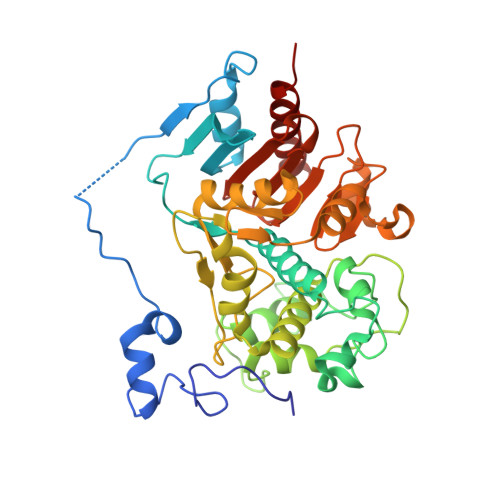Molecular design of a nylon-6 byproduct-degrading enzyme from a carboxylesterase with a beta-lactamase fold.
Kawashima, Y., Ohki, T., Shibata, N., Higuchi, Y., Wakitani, Y., Matsuura, Y., Nakata, Y., Takeo, M., Kato, D., Negoro, S.(2009) FEBS J 276: 2547-2556
- PubMed: 19476493
- DOI: https://doi.org/10.1111/j.1742-4658.2009.06978.x
- Primary Citation of Related Structures:
2E8I, 2ZM0, 2ZM7, 2ZMA - PubMed Abstract:
A carboxylesterase with a beta-lactamase fold from Arthrobacter possesses a low level of hydrolytic activity (0.023 mumol.min(-1).mg(-1)) when acting on a 6-aminohexanoate linear dimer byproduct of the nylon-6 industry (Ald). G181D/H266N/D370Y triple mutations in the parental esterase increased the Ald-hydrolytic activity 160-fold. Kinetic studies showed that the triple mutant possesses higher affinity for the substrate Ald (K(m) = 2.0 mm) than the wild-type Ald hydrolase from Arthrobacter (K(m) = 21 mm). In addition, the k(cat)/K(m) of the mutant (1.58 s(-1).mm(-1)) was superior to that of the wild-type enzyme (0.43 s(-1).mm(-1)), demonstrating that the mutant efficiently converts the unnatural amide compounds even at low substrate concentrations, and potentially possesses an advantage for biotechnological applications. X-ray crystallographic analyses of the G181D/H266N/D370Y enzyme and the inactive S112A-mutant-Ald complex revealed that Ald binding induces rotation of Tyr370/His375, movement of the loop region (N167-V177), and flip-flop of Tyr170, resulting in the transition from open to closed forms. From the comparison of the three-dimensional structures of various mutant enzymes and site-directed mutagenesis at positions 266 and 370, we now conclude that Asn266 makes suitable contacts with Ald and improves the electrostatic environment at the N-terminal region of Ald cooperatively with Asp181, and that Tyr370 stabilizes Ald binding by hydrogen-bonding/hydrophobic interactions at the C-terminal region of Ald.
Organizational Affiliation:
Department of Materials Science and Chemistry, Graduate School of Engineering, University of Hyogo, Japan.

















